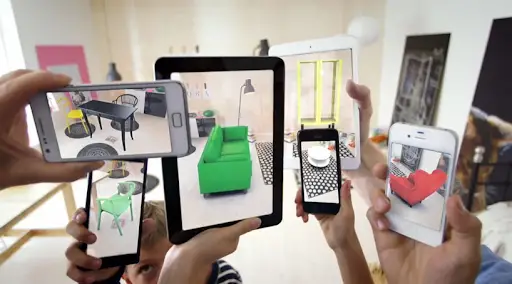How Augmented Reality Will Shape Mobile App Development in Future
These days, augmented reality (AR) apps aid law enforcement and security organisations in maintaining security and building simulated environments for planning.
The ability to display virtual reality on smartphone screens has been made possible by the widespread use of mobile apps in every nook and cranny. There, augmented reality (AR) and virtual reality (VR) are introduced. These technologies have both broadened the possibilities for mimicking reality and blended the real and virtual worlds to provide a more realistic user experience.
Let’s use AR as an example. The real-world applications of AR make it the more intriguing and potent of the two technologies. It gives the reality depth and offers a realistic and engaging experience.
The function of mobile augmented reality (AR) in the development of mobile apps and its significance for creating cutting-edge app solutions will be discussed in this article. It is not overstatement to say that augmented reality has the potential to transform the whole field of mobile app development in 2019 and beyond.
Applications for Augmented Reality: Benefits
Let’s briefly go through the advantages of AR apps first, though. These advantages—which you may find to be unconnected to the subject—can provide you a peek of the opportunities this booming technology has opened up for both enterprises and developers.
These days, augmented reality (AR) apps aid law enforcement and security organisations in maintaining security and building simulated environments for planning. These are the main advantages of mobile AR apps.
- Compared to “non-AR” apps, they improve and increase the interaction with the user experience.
- By doing so, they can narrow the divide between the physical and virtual worlds and produce an immersive experience.
- AR applications help businesses combine location-based data and interactively display it.
- Through a realistic experience, augmented reality may dramatically increase user engagement.
- AR applications can help businesses target niche customers with sophisticated user experiences.
The Statista analysis predicts that by 2020, AR-based apps will bring in a staggering $6200 million in revenue. By the end of 2020, we will have about 200 million users, if we translate it into user numbers.
How AR Affects the Development of Mobile Apps
Users may now enjoy this amazing technology via apps, proving that augmented reality has expanded beyond video games. Take Pokemon Go as an example. It was one of the most popular mobile apps in 2016, and more than 500 million people had downloaded it worldwide. But today, mobile app development firms offer AR technology for industrial areas including health, education, entertainment, and retail in addition to the gaming industry.
The greatest platforms for AR mobile application development are iOS and Android. These OS’s hardware and software are suitable for integrating AR. In other words, the booming AR technology can efficiently utilise the cameras, GPS, sensors, and gyroscope found in Android and Apple devices. With the use of AR technology, any iOS or Android app development solution can become more dynamic and user-friendly.
Applications that deal with user data, routine jobs, intricate operations, training courses, and inventory might benefit greatly from augmented reality. It’s interesting that AR technology has applications for entertainment. Yes, by offering a good experience, it can draw in and keep app users. Snapchat and Musical.ly, which offer its users a high level of enjoyment, are highly addictive to many people.
Below are a few notable applications of AR innovation.
Actual 3D Objects
3D models can be very helpful for understanding the products in both education and retail. It is feasible to simulate 3D things with AR technology. The viewers can view the 3D versions of the real-world objects in a simulated environment thanks to AR technology.
Place of Use
With AR technology, it is simple to determine the user’s location and display content based on it. AR-based apps may easily find the user’s precise location by using GPS and location-based services. With the aid of various technologies and displays, the technology can locate the pertinent content based on the location.
Obstacles to the Development of Augmented Reality Apps
At this point, there are two significant obstacles to popularising AR in the process of app development
Location Monitoring
Let’s be honest. For AR-based apps, location monitoring is restricted to a defined scale. For instance, it is challenging to pinpoint a precise location in crowded situations or interior settings. To fully utilise position tracking in mobile AR apps, GPS and location-related technology must advance.
Protection of Privacy
In AR apps, privacy is a big problem. These apps store the user’s private information, which is easily accessible to everyone. The user’s personal information and other sensitive data must be protected by the AR technology.
As AR technology develops over time and becomes more widely used, we may anticipate that all of these difficulties will be overcome.
Finishing Lines
In conclusion, we are confident that practically every industry sector will profit from this amazing technology in the near future. Therefore, it appears that the growth of augmented reality in mobile app development is unstoppable. This technology will soon be required for creating the newest commercial apps.
Our devoted and skilled developers at Solution Analysts can use cutting-edge technological trends like Virtual Reality (VR), Augmented Reality (AR), and the Internet of Things (IoT) when creating tailored, enterprise-grade mobile app solutions.




